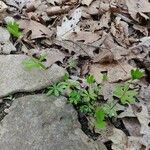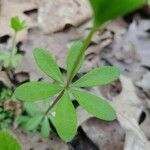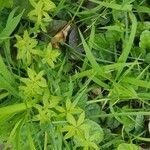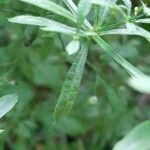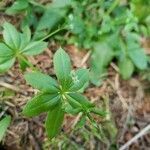Perennial; stems 2–8 dm, prostrate or scrambling, usually retrorsely hooked-scabrous on the angles at least below; lvs vanilla-scented, mostly in 6’s, or only 4 on the smaller branches, narrowly elliptic to oblanceolate, cuspidate, 1.5–5 cm, 1-nerved, generally antrorsely scabro-ciliate on the margins and retrorsely hooked-scabrous on the midrib beneath, otherwise mostly glabrous; infls axillary or also terminal, the peduncles simple and 3-fld to repeatedly branched; fls greenish-white, 2–3 mm wide; fr 1.5–2 mm, uncinate-bristly; 2n=44, 66. Woods; circumboreal, s. in Amer. to Fla. and Mex. June– Aug. Southeastern plants, occasionally extending n. to our range, have reduced upper lvs and branching peduncles, forming a diffuse infl, and have been segregated as var. asprelliforme Fernald, but are not well set off from the more northern phase, common in our range (var. triflorum) with merely 3-fld axillary peduncles.
A herb. The stems are weak and have many bristles. They fork freely. The leaves are thin and deep green. They are in rings of 6. The flowers are greenish-white. They have long stalks. They are borne in clusters of 3. The fruit are 2 rounded, bristly nutlets.
